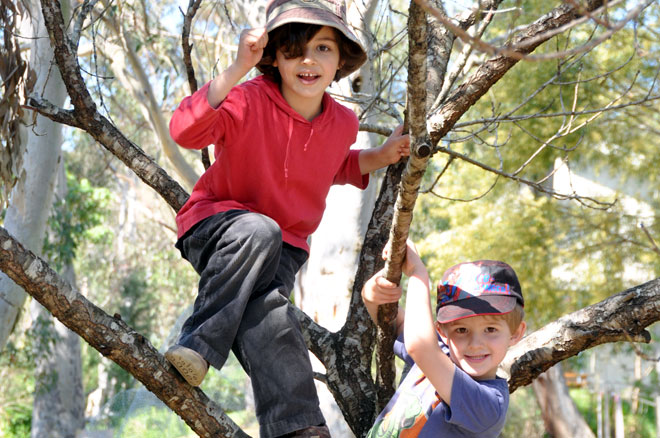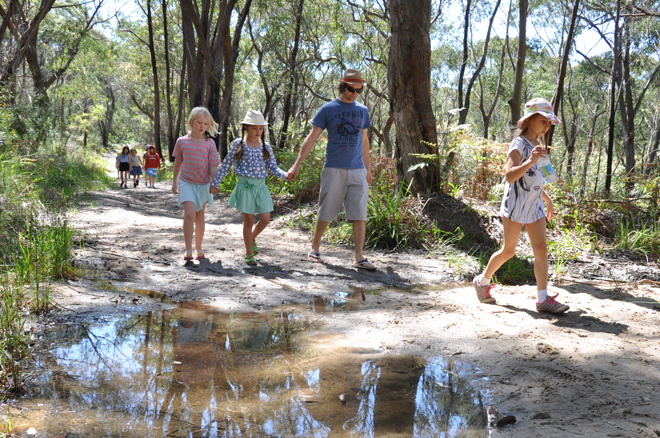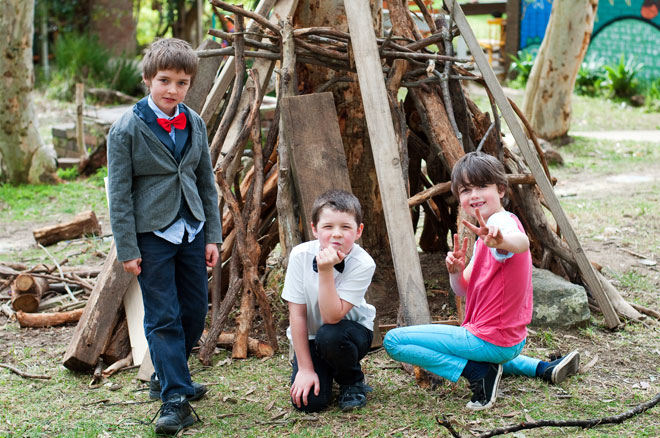Primary FAQs
What sort of people does Kinma appeal to?
Kinma parents are a diverse group who cannot be categorised into a particular occupation, educational background or lifestyle. There are professionals, academics, artists, students, teachers, trades-people, writers, stay-at-home mums & dads, executives and small business owners (just to name a few!).
Kinma parents do share some common beliefs. For example: they want an educational environment that adapts to the individual needs of their child; they are interested in life skills as well as academic skills; they want their child to discover and never lose the wonder of learning; they are looking for a sense of community and the opportunity to be meaningfully involved in their child's school.
At what age can children start at Kinma?
Children can join the primary group from the age of 4, and children can stay until the age of 13 years. We talk in age rather than grade at Kinma because interest and ability rather than the familiar age/grade format, group our students.
What if my child isn't ready for school at the beginning of the year?
At Kinma, your child can start school at any stage throughout the year. If your child isn't ready for school in February, he may be ready in May. Unlike mainstream schools, you don't have to wait until the commencement of the next school year.
At Kinma, you can ease the transition to school by tailoring the week to suit your child's needs. Young children can become tired and overwhelmed with the demands of a new environment and a five day school week. Many families give their child a mid-week break to recharge their batteries.

If my child starts school mid-year, won't he miss important learning?
No! Each child at Kinma is allowed to learn and progress at their own pace. Learning experiences for your child would be planned around his own individual needs, interests and abilities.
Research shows that learning is a developmental process. It is unrealistic to expect children to learn to walk or talk at the same time. It is just as unrealistic to expect children to learn to read and write at the same time.
By not focusing on traditional age divisions our children have more time to develop skills and competencies without judgement or alienation. This freedom allows students to surpass the average expectation for the grade/age or to spend time to increase confidence.
Is it true that children can play all day at Kinma?
Play IS highly valued at Kinma. But don't worry - the good news is that your child can play and learn at the same time! Traditionally there has been a separation between play and learning in our schools. Learning happened in the classroom. Play happened in the playground, after lunch. This separation of play and learning goes against all the theoretical principles of child development and learning.
If you study education or child development today you learn that play is essential to learning. For example, it is through play that children construct knowledge; refine their learning; develop creativity and imagination and gain control and confidence. If we have this knowledge it makes sense for a school to embrace play as part of it's curriculum.
Unfortunately, implementing theory into practice takes time. When Kinma led the way over 30 years ago, mainstream schools were still not giving children much opportunity for structured or unstructured play.
Today, most schools recognise the importance of play. However the wheels of change are slow in a big machine like the Department of Education so they still have some catching up to do! Consequently you will notice a greater emphasis at Kinma on things like:
- Active, hands on learning
- Meaningful, relevant learning experiences
- Interactive teaching and co-operative learning
- Creating indoor and outdoor environments rich in opportunities to explore & create
It should also be said that at Kinma children cannot spend every day playing, isolated from their friends or their learning needs. While we value play, it is used as a means of achieving the NSW curriculum outcomes and learning valuable life lessons and skills. At Kinma, we aim for balance and harmony and the individual needs of the child in everything we do.

If the children have so much fun, will my child still learn to read, write and do maths?
Yes. Everything that happens at Kinma is grounded in a strong knowledge of how children learn and develop. We are coming from a place of established educational theory and research so we are not too 'out there'.
Kinma children achieve the same NSW Curriculum outcomes as mainstream schools do (we have the highest NSW Board of Studies accreditation). But by making learning fun and letting children learn at their own place, we have kids who love coming to school, love learning and tend to learn quickly and easily.
How does Kinma help children in the transition between preschool and primary school?
Kinma has a strong transition programme for young children entering the primary school. It is our aim to make the transition a gentle one which supports the children and their families and takes care of their very individual needs.
Children start primary when they are really ready.
Unlike most schools, children can start at Kinma at any stage throughout the year. Often children aren't quite ready for school at the beginning of the year, or perhaps they aren't old enough. Rather than having to wait 12 months until the beginning of the next school year, they have the opportunity of starting when their parents and preschool teacher agree they are ready to make a successful transition.
Children visit the primary extensively throughout Term 4.
Most schools have an orientation day at the end of the year to help children become familiar with the school environment. At Kinma the preschool children who will be moving to the primary visit the primary classroom for short periods of time on almost a daily basis. In this way, they get to know their future teacher and classmates and become familiar with the rhythm of life at school. This makes for a gentle transition period.
Parents can help their child settle in at school
There is no drop, kiss and leave policy at Kinma. Parents are encouraged to stay in the classroom for as long as they need to to help their child feel safe, settled, and secure in the classroom and the daily routine.
Children can start with a shorter week
Starting school can be an overwhelming and tiring experience for some children. Tired children will not have the energy or motivation to get the most from their school day. A day at home to recharge their batteries helps to make the beginning of school a happy, positive and successful experience.

How can Kinma do things that other schools can't?
We have small classes that tailor individual learning programmes for each child. We don't expect that all children will be learning and achieving exactly the same thing at the same time. So if they take a day off during the week, they won't miss out on learning the letter "m" or if they start mid-year they won't have missed addition!
Why does Kinma have mixed age classes?
School is one of the few places in society that divides us from our peers on the basis of age. Kinma creates a more authentic and traditional social environment where classes are structured in a similar way to that of a family or workplace.
In the “community classes” children of different ages, experiences and abilities work together in small groups and engage in learning activities planned with their teacher. Learning occurs in a variety of surroundings from the whole class to small groups and individual settings. Children work with each other, developing and sharing knowledge, testing theories and reflecting on their learning. Teachers work as facilitators of this social learning process, monitoring group and individual development.
Benefits:
- Children learn to work collaboratively; they can take the role of ‘student’ or ‘teacher’ with their peers.
- Research indicates that children who have participated in mixed age classes continue to be more pro-social and less aggressive.
- The children are grouped flexibly according to the needs of the learning community e.g. their interests, competencies, a specific learning need or social skills development.
- The child’s individuality is met through small flexible groups which allows the teachers to build on children’s competencies and interests.
- The children have the chance to learn in a way that meets their own learning style rather than a one size fits all approach to education.
- Children learn from one and other, the teacher, parents and the environment. Rather than a sterile silent classroom, a child’s environment and learning is enhanced by movement and interaction.

What happens to students after Kinma?
Kinma provides children with a strong academic, emotional, and social foundation. Along with the important basic skills, Kinma children take with them a love of learning, a strong sense of self and well developed thinking and communication skills. Following their Kinma education students select a wide variety of high schools to suit their individual needs and interests, and adapt to different settings extremely well.
Many Kinma students have chosen to continue their education in colleges and universities all over the country, and abroad. Many have entered directly into the worlds of business, trades, arts, crafts, and technical vocations.
Former Kinma students see themselves as confident and competent members of society, capable of defining meaningful goals for their lives and finding ways to achieve them.
Term Dates 2025
- Term 1: Tues 4 February to Fri 11 April
- Term 2: Wed 30 April to Fri 27 June
- Term 3: Wed 23 July to Fri 26 Sep
- Term 4: Wed 15 Oct to Wed 17 Dec
Term Dates 2026
- Term 1: Mon 2 Feb – Thu 2 April
- Term 2: Wed 22 April – Fri 26 June
- Term 3: Wed 22 July – Fri 25 Sep
- Term 4: Wed 14 oct – Wed 16 Dec
Contact us
127 Coolowie Rd,
Terrey Hills NSW 2084
Find us on Google Maps
Primary: +61 2 9450 0738
Preschool: +61 2 9486 3018
Email Kinma

